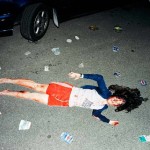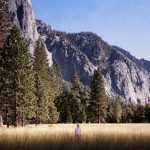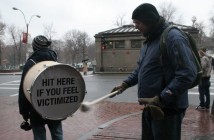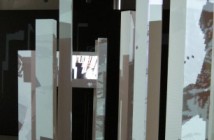REKA REISINGER @ REAL ART WAYS
Over the past several years, photography has evolved from a replica of the world we live in, to a carefully constructed and digitally enhanced version of reality. In her new show entitled Cutouts, Reka Reisinger’s series of self portraits tackles this theme with images that are both visually confusing and undeniably authentic. The Hungarian-born artist constructs life-size cardboard cutouts of her own likeness by hand and then re-photographs them out in the world where Reisinger does “…not use any digital manipulation to composite the pictures”. The end result is a disjointed and collaged look that explores the “…sometimes-indistinguishable relationship between the real and fake.”
Reisinger’s portraits range from backdrops of vast, open, and untouched scenes of nature to the developed and bustling heart of New York City, where the artist lives and works today. In Untitled (Time Square), Reisinger’s cutout stands in the middle of the gleaming and bustling city streets. Surrounded by bright lights and larger-than-life advertisements; the scene highlights the digitally altered imagery that bombards our senses every day. What’s interesting is the fact that Reisinger’s propped-up portrait is, in many ways, less artificial than its highly stylized surroundings. While the promotional posters and neon advertisements lining the streets have been edited, touched up, and approved by many sets of discerning eyes before reaching the public; Reisinger’s portrait is an unaltered, traditional photograph that has been hand-crafted by a single artist. This disparity creates tension between trusting what we perceive as realistic and what is truly real.
Several of the portraits in the Cutouts series are set in picturesque scenes of American landscapes. In her photograph Untitled (Yosemite), Reisinger’s flat portrait stands in tall grass with immense mountains and evergreens behind her. The scene resembles a primitive digital experiment “from the early days of Photoshop” where Reisinger’s image is crudely pasted over this pristine backdrop. Ironically, images of nature are often enhanced with light, color, and carefully choreographed composition using this technology. By creating this "collaged and altered” look in a new way, Reisinger brings attention to advances in digital photography by using a traditional in-camera processes. The act of an original alteration is preserved, behaving as both a record of performance and a altered projection of self.
Some of Reisinger’s photographs feature her cardboard cutout engaged in pseudo-relationships with other individuals, interacting with them in various situations. In Untitled (Birthday), one of Reisinger’s cutouts stands among a circle of friends, propped up in position to blow out the candles on her birthday cake. The relationship between the inanimate cutout and her surroundings serves as a commentary on the logic of pictures that have been pieced together with digital technology. Often scenes that portray romantic relationships or friendships are composite together, with no authentic connection between the original figures. In some ways, the concept of Reisinger’s two-dimension figure standing in with these individuals is a lot more “real” than a highly polished photo composite together after multiple photo-shoots, digital editing, and extensive consultation with creative experts. By making the seams obvious, you see Reisinger's desires made out in plain view, rather than illusion.
Many of Reisinger’s portraits play off the illogical nature of modern photographs with a great sense of humor. Her Untitled (Bathroom) photo, the legs of her cutout peek out from under a public bathroom stall — an unromantic and mildly grotesque scene. In Untitled (Swimsuit) her cardboard portrait stands ankle-deep in a wading pool decked out in scuba gear and flippers. Set on what appears to be a hotel resort, the landscape is complete with white plastic chairs and a maintenance worker in the background. With the imagery of palm trees and blue water, the photo represents an idealistic advertisement for anything from Corona to designer swimsuits. However, the inherent humor and awkwardness of the scene bring out its ultimate truthfulness. It reminds us that although we venerate those pristine and perfectly fine-tuned images, Reisinger’s distracting visual background noise and disenchanted version is much closer to our everyday experience.
By orchestrating these scenes with a cutout of her own image, Reisinger’s work is reminiscent of performance art suspended in time. Yet instead of making herself the subject, Reisinger is using her image as a vehicle to explore the relationship between the technology and image making in our world today. Her work can be compared to Cindy Sherman's famed Untitled Film Stills series, circa 1977. The pictures were a parody of “…fan-magazine glimpses into the life (or roles) of an imaginary blonde actress…) played by Sherman herself.” Sherman’s series investigated the expectations and limitations of female figures in cinematography of the time. These photographs, like Reisinger’s, are not about creating ordinary portraits; but use the artist’s own figure to explore broader themes that comment on the expectations that we bring to an image.
Just as modern painting responded to photography by exploring the uniqueness of its flat surface and corporeal medium; modern photography is now defying the new technology of digital imaging by focusing on its ability to capture an authentic moment in time. Reisinger’s pieces offer a subtle distinction from shiny, perfectly sculpted, photographic imagery that we’ve become accustomed to in our everyday sensory experience. In doing so, she raises interesting questions about the truthfulness of the medium, the technology behind the finished product we see, and our attraction to glamorized digital images that are not from this world.
- Reka Reisinger, Untitled
- Reka Reisinger, Yosemite
- Reka Reisinger, Street Portrait
"Reka Reisinger" is on view August 21 - October 12, 2008 at Real Art Ways, located at 56 Arbor St, in Hartford, CT
All images are courtesy of the artist and Real Art Ways.







